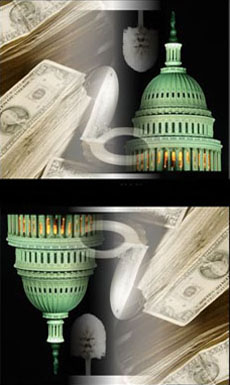The Central Intelligence Agency was created in 1947 with the signing of the National Security Act by President Truman.
Peter J. Goss is currently Director of Central Intelligence. He was confirmed on 24 Sept. 2004.
The Executive Director of the Central Intelligence Agency is currently under cover.
The EXDIR runs the CIA on a day-to-day basis.
All publicly available information released by the CIA is controlled by the Public Affairs Staff.
The Center for the Study of Intelligence maintains the Agency's historical materials and promotes the study of intelligence
as a legitimate and serious discipline.
The current director is Paul M. Johnson.
The Intelligence Cycle is the process of developing raw information into finished intelligence for policymakers to use
in decisionmaking and action.
There are five steps which constitute the Intelligence Cycle.
1. Planning and Direction
This is management
of the entire effort, from identifying the need for data to delivering an intelligence product to a consumer.
It is the beginning and the end of the cycle--the beginning because it involves drawing up specific collection requirements
and the end because finished intelligence, which supports policy decisions, generates new requirements.
The whole process
depends on guidance from public officials. Policymakers--the President, his aides, the National Security Council and other
major departments and agencies of government--initiate requests for intelligence.
2. Collection
...is the gathering
of the raw information needed to produce finished intelligence.
Open source reporting is integral to CIA's analytical capabilities.
There are also secret sources of information. CIA's operations officers collect such information from agents abroad and
from defectors who provide information obtainable in no other way.
Finally, technical collection--electronics and satellite photography--plays an indispensable role in modern intelligence,
such as monitoring arms control agreements and providing direct support to military forces.
3. Processing
...involves converting the vast amount of information collected to a form usable by analysts through
decryption, language translations and data reduction.
4. All Source Analysis and Production
...is the conversion of basic information into finished intelligence.
It includes integrating, evaluating and analyzing all available data--which is often fragmentary and even contradictory--and
preparing intelligence products.
Analysts, who are subject-matter specialists, consider the information's reliability, validity, and relevance.
They integrate data into a coherent whole, put the evaluated information in context, and produce finished intelligence
that includes assessments of events and judgments about the implications of the information for the United States.
The
CIA devotes the bulk of its resources to providing strategic intelligence to policymakers.
It performs this important function by monitoring events, warning decisionmakers about threats to the United States, and
forecasting developments.
The subjects involved may concern different regions, problems, or personalities in various contexts--political, geographic,
economic, military, scientific, or biographic.
Current events, capabilities, and future trends are examined.
The CIA produces numerous written reports, which may
be brief, one page or less--or lengthy studies.
They may involve current intelligence, which is of immediate importance, or long-range assessments.
The Agency presents some finished intelligence in oral briefings.
The CIA also participates in the drafting and production of National Intelligence Estimates, which reflect the collective
judgments of the Intelligence Community.
5. Dissemination
The last step, which logically feeds into the first,
is the distribution of the finished intelligence to the consumers, the same policymakers whose needs initiated the intelligence
requirements.
Finished intelligence is hand-carried daily to the President and key national security advisers.
The policymakers, the recipients of finished intelligence, then make decisions based on the information and these decisions
may lead to the levying of more requirements, thus triggering the Intelligence Cycle.
The CIA Seal

Interpretation of the CIA Seal
The American Eagle is the national bird and is a symbol of strength and alertness.
The radiating spokes of the compass rose depict the coverage of intelligence data from all areas of the world to a central
point.
Section 2 of the Central Intelligence Agency Act of 1949 provided for a seal of office for CIA.
The design of the seal was approved and set forth on 17 February 1950 in President Harry Truman's Executive Order 10111.
In this Order, the CIA seal is described in heraldic terms as follows:
SHIELD: Argent, a compass rose of sixteen
points gules.
CREST: On a wreath argent and gules an American bald eagle's head erased proper.
Below the shield on a gold color scroll the inscription "United States of America" in red letters and encircling the shield
and crest at the top the inscription "Central Intelligence Agency" in white letters.
All on a circular blue background with a narrow gold edge.
The Memorial Garden
Situated on the hillside between the Original Headquarters Building and the Auditorium is the Memorial Garden.
Designed in 1995 by Sheila Brady of landscape architects Oehme, Van Sweden & Associates, the garden makes exceptional
use of the natural environment.
An inscribed brass plaque which reads "In remembrance of those whose unheralded efforts served a grateful nation" is set
in fieldstone which surrounds a large pond.
The blend of natural and landscaped plantings amid the stone outcroppings, from which a cascade of water continuously falls,
has created a tranquil and reflective retreat for Agency employees.
The Memorial Stars
The words and stars in the photograph above, carved in the marble facade of the north wall of the foyer of the CIA Headquarters
Building, silently but permanently immortalize those CIA officers who lost their lives in the service of their country.
The glass-encased Book of Honor located below the stars displays the names of those whose names can, in death, now be revealed.
This
simple but starkly elegant memorial was sculpted by Harold Vogel in July 1974, having been commissioned by the Fine Arts Commission
of the Central Intelligence Agency in May 1973.
http://www.darkgovernment.com/cia.html
Central Intelligence Agency
http://www.cia.gov/
Director of Central Intelligence
http://www.cia.gov/dci/index.html
http://www.cia.gov/cia/information/info.html
